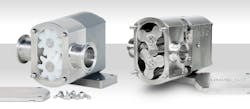By Peter Engstrom
Monitoring a control valve’s position in process industries is typically done using conventional cabled position switches meant for normal manufacturing environments. These include electromechanical limit switches, proximity sensors, magnetic switches and photoelectric sensors.
While these devices address the functional requirements for sensing "open/closed" valve positions, inherent design characteristics may limit their life expectancy or make them unsuitable for use in potentially explosive gas/dust environments.
For such cases, there are position switches and sensors designed expressly for demanding conditions. Their application is described in two examples below.
Besides the two examples discussed, wireless contact (e.g. electromechanical limit switches) and non-contact (e.g. magnetic sensors, inductive proximity sensors, photoelectric sensors) are used for position monitoring and control in many process-related applications, including:
- Monitoring doors/windows in grain silos
- Position monitoring of marine loading arms
- Material handling/conveyor systems
- Printing processes
- Wood processing systems
- Chemical processing and packaging
- Position monitoring of fire protection flaps
Monitoring valve position
In the first example, derived from a natural gas pumping station, the notion was that the open and closed positions of the manually operated valves be detected and that appropriate control signals be sent to a control center.
To achieve this, two wireless electromechanical limit switches were fixed to the valve head. Each was actuated by a "flag/cam" mounted to the valve head (Figure 1).
By design, these ATEX-IECEx-rated position switches operate at an extremely low voltage and current level, and well below any power level capable of producing a spark. Each features an electro-dynamic energy generator, precluding the need for a battery or external power source.
The energy generator converts the mechanical displacement of the actuating arm to electrical energy using the movement of a coil through a magnetic field. This "energy harvesting" mechanism generates sufficient electrical power to send a wireless, encoded control signal to a wireless receiver mounted outside the hazardous zone.
Filler pipe positioning
Similar wireless switches proved of value in a refinery’s tank truck filling facility. Here the goal was to ensure that the neck of the fuel filling pipe was properly positioned above the opening in the tank truck being loaded (Figure 2).
Sensing of this alignment was initially accomplished using a "hard-wired" limit switch actuated by a mechanical lever. A steel wire acted as a "mechanical limit" such that the hand lever could only be operated when the fill neck was in position above the tank truck’s fill opening.
While this solution was functional, the electrical cables from the switches to the control panel quickly wore and could be damaged by the frequent movement and chafing by the fuel pipe. Replacing the "cabled" switches with wireless functional-equivalents eliminated the problem, resulting in a reliable, robust long-term solution (Figure 3).
In both of the examples discussed, the users benefited from the reduced maintenance required, especially given there are no batteries or cables to replace. With no cables to run to the control cabinet installation costs were reduced. The cost of Ex-Rated cables and connectors was eliminated.
The use of "radioed" signals allowed the control cabinets to be located outside the explosion-risk area and safe operation was realized in Zone 1 and Zone 2 explosion-risk areas.
Peter Engstrom is managing director with STEUTE Industrial Controls, Ridgefield, Conn.
Steute is a specialist in the development and production of safe and reliable switch gear for complex and critical applications.


